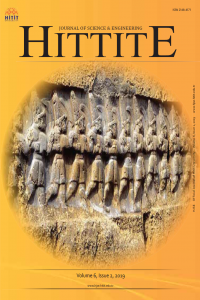Abstract
References
- Cakmak H., Gurpuz G.E., Bozdogan N., Kumcuoglu S., Tavman S. Dispersed Phase and Emulsification Conditions on the Stability of Water-in-Oil Emulsion. Food Studies 7(1) (2017) 29-37.
- Silva K.A., Rocha-Leão M.H., Coelho M.A.Z. Evaluation of aging mechanisms of olive oil–lemon juice emulsion through digital image analysis. Journal of Food Engineering, 97(3) (2010) 335-340.
- Ushikubo F.Y., Cunha R.L. Stability mechanisms of liquid water-in- oil emulsions. Food Hydrocolloids 34 (2014) 145-153.
- Maali A., Mosavian, M.H. Preparation and application of nanoemulsions in the last decade (2000–2010). Journal of Dispersion Science and Technology 34(1) (2013) 92-105.
- Eisinaite V., Juraite D., Schroën K., Leskauskaite, D. Preparation of stable food-grade double emulsions with a hybrid premix membrane emulsification system. Food Chemistry 206 (2016) 59- 66.
- Tadros T., Izquierdo P., Esquena J., Solans, C. Formation and stability of nano-emulsions. Advances in Colloid and Interface Science 108 (2004) 303-318.
- McClements D.J. Protein-stabilized emulsions. Current Opinion in Colloid & Interface Science 9(5) (2004) 305-313.
- Sun C., Gunasekaran S., Richards, M.P. Effect of xanthan gum on physicochemical properties of whey protein isolate stabilized oil- in-water emulsions. Food Hydrocolloids 21(4) (2007) 555-564.
- Ercelebi E.A., Ibanoğlu, E. Influence of hydrocolloids on phase separation and emulsion properties of whey protein isolate. Journal of Food Engineering 80(2) (2007) 454-459.
- Tan C.P., Man, Y.C. Differential scanning calorimetric analysis of edible oils: comparison of thermal properties and chemical composition. Journal of the American Oil Chemists' Society 77(2) (2000) 143-155.
- Chiavaro E., Vittadini E., Rodriguez-Estrada M.T., Cerretani L., Bendini A. Differential scanning calorimeter application to the detection of refined hazelnut oil in extra virgin olive oil. Food Chemistry 110(1) (2008) 248-256.
- Fasina O.O., Craig-Schmidt M., Colley Z., Hallman H. Predicting melting characteristics of vegetable oils from fatty acid composition. LWT-Food Science and Technology 41(8) (2008) 1501-1505.
- Jafari M., Kadivar M., Keramat, J. Detection of adulteration in Iranian olive oils using instrumental (GC, NMR, DSC) methods. Journal of the American Oil Chemists' Society 86(2) (2009) 103-110.
- Calligaris S., Sovrano S., Manzocco L., Nicoli, M.C. Influence of crystallization on the oxidative stability of extra virgin olive oil. Journal of Agricultural and Food Chemistry 54(2) (2006) 529-535.
- Barba L., Arrighetti G., Calligaris S. Crystallization and melting properties of extra virgin olive oil studied by synchrotron XRD and DSC. European Journal of Lipid Science and Technology 115(3) (2013) 322-329.
Abstract
W ater-in-oil w/o primary food emulsions are often used for encapsulation of bioactive food ingredients or preparing multiple emulsions, however there is a lack of study about evaluation of stability of these emulsions by adding food materials in the dispersed phase. In this study, water-in-olive oil emulsions were prepared with using different dispersed phases; maltodextrin MD , whey protein isolate WPI and maltodextrin+whey protein isolate MD+WPI mixture 1:1 w/w solutions were used at different rates to determine the effects of dissolved material on physical, chemical, rheological and thermal properties of the emulsions. The kinetic stability of emulsions were significantly improved with increasing rates of soluble materials p
References
- Cakmak H., Gurpuz G.E., Bozdogan N., Kumcuoglu S., Tavman S. Dispersed Phase and Emulsification Conditions on the Stability of Water-in-Oil Emulsion. Food Studies 7(1) (2017) 29-37.
- Silva K.A., Rocha-Leão M.H., Coelho M.A.Z. Evaluation of aging mechanisms of olive oil–lemon juice emulsion through digital image analysis. Journal of Food Engineering, 97(3) (2010) 335-340.
- Ushikubo F.Y., Cunha R.L. Stability mechanisms of liquid water-in- oil emulsions. Food Hydrocolloids 34 (2014) 145-153.
- Maali A., Mosavian, M.H. Preparation and application of nanoemulsions in the last decade (2000–2010). Journal of Dispersion Science and Technology 34(1) (2013) 92-105.
- Eisinaite V., Juraite D., Schroën K., Leskauskaite, D. Preparation of stable food-grade double emulsions with a hybrid premix membrane emulsification system. Food Chemistry 206 (2016) 59- 66.
- Tadros T., Izquierdo P., Esquena J., Solans, C. Formation and stability of nano-emulsions. Advances in Colloid and Interface Science 108 (2004) 303-318.
- McClements D.J. Protein-stabilized emulsions. Current Opinion in Colloid & Interface Science 9(5) (2004) 305-313.
- Sun C., Gunasekaran S., Richards, M.P. Effect of xanthan gum on physicochemical properties of whey protein isolate stabilized oil- in-water emulsions. Food Hydrocolloids 21(4) (2007) 555-564.
- Ercelebi E.A., Ibanoğlu, E. Influence of hydrocolloids on phase separation and emulsion properties of whey protein isolate. Journal of Food Engineering 80(2) (2007) 454-459.
- Tan C.P., Man, Y.C. Differential scanning calorimetric analysis of edible oils: comparison of thermal properties and chemical composition. Journal of the American Oil Chemists' Society 77(2) (2000) 143-155.
- Chiavaro E., Vittadini E., Rodriguez-Estrada M.T., Cerretani L., Bendini A. Differential scanning calorimeter application to the detection of refined hazelnut oil in extra virgin olive oil. Food Chemistry 110(1) (2008) 248-256.
- Fasina O.O., Craig-Schmidt M., Colley Z., Hallman H. Predicting melting characteristics of vegetable oils from fatty acid composition. LWT-Food Science and Technology 41(8) (2008) 1501-1505.
- Jafari M., Kadivar M., Keramat, J. Detection of adulteration in Iranian olive oils using instrumental (GC, NMR, DSC) methods. Journal of the American Oil Chemists' Society 86(2) (2009) 103-110.
- Calligaris S., Sovrano S., Manzocco L., Nicoli, M.C. Influence of crystallization on the oxidative stability of extra virgin olive oil. Journal of Agricultural and Food Chemistry 54(2) (2006) 529-535.
- Barba L., Arrighetti G., Calligaris S. Crystallization and melting properties of extra virgin olive oil studied by synchrotron XRD and DSC. European Journal of Lipid Science and Technology 115(3) (2013) 322-329.
Details
| Primary Language | English |
|---|---|
| Journal Section | Research Article |
| Authors | |
| Publication Date | June 30, 2019 |
| Published in Issue | Year 2019 Volume: 6 Issue: 2 |
Hittite Journal of Science and Engineering is licensed under a Creative Commons Attribution-NonCommercial 4.0 International License (CC BY NC).


